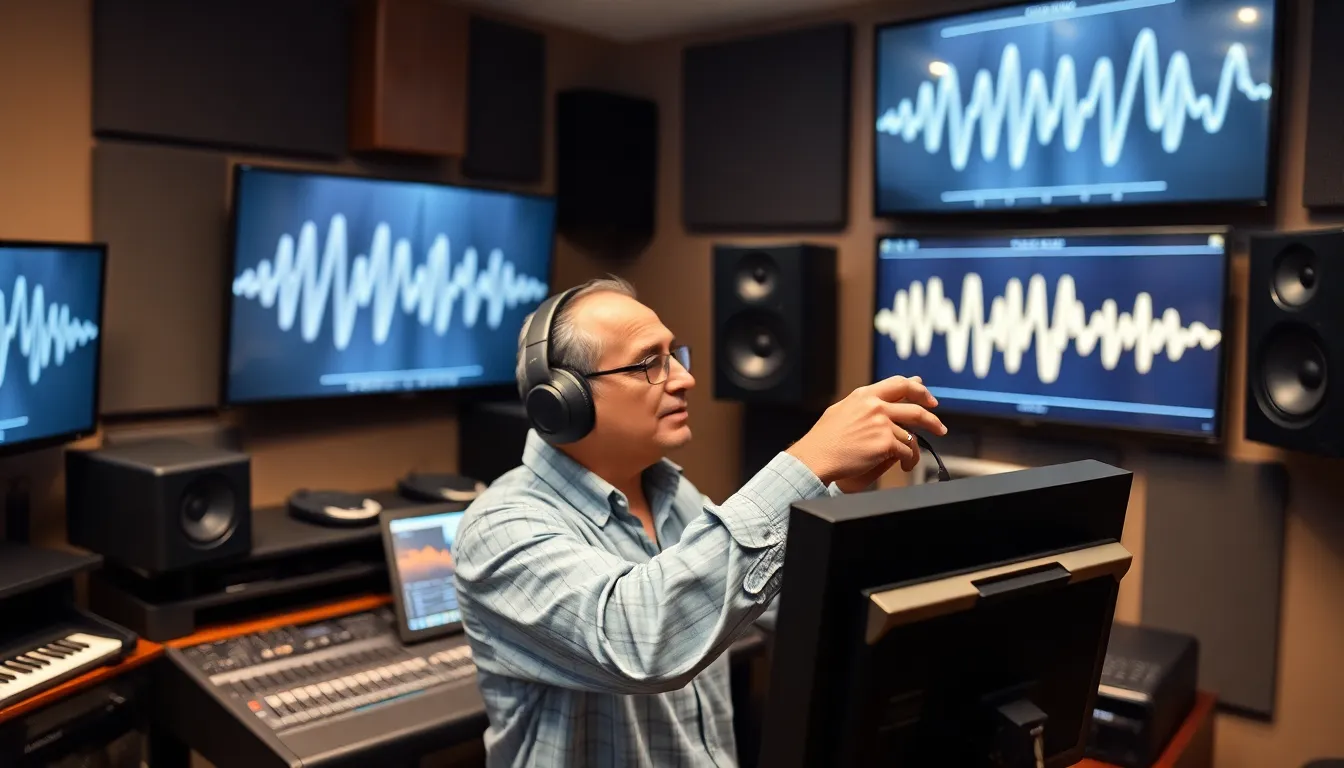Imagine tuning into your favorite song and feeling every beat resonate deep within. That magic happens thanks to audio wavelengths, the invisible waves that carry sound through the air. Understanding these wavelengths can unlock a world of sonic possibilities, whether you’re a budding musician or just someone who loves a good jam session.
Table of Contents
ToggleUnderstanding Audio Wavelength
Audio wavelengths represent the distance between successive peaks of sound waves. Comprehending these wavelengths proves essential for anyone working with sound, from musicians to sound engineers.
Definition of Audio Wavelength
Audio wavelength refers to the physical length of a single cycle of a sound wave. This length is inversely related to frequency; higher frequencies result in shorter wavelengths, and lower frequencies correspond to longer wavelengths. For example, a sound wave with a frequency of 440 Hz (the note A4) has a wavelength of approximately 0.78 meters in air. Understanding these measurements allows for better sound manipulation in various environments.
Importance in Sound Engineering
Sound engineers rely on audio wavelengths to shape and modify sound effectively. Accurate wavelength knowledge aids in tasks like mixing, mastering, and sound design. Engineers match wavelengths to control spatial effects, such as reverb and delay, ensuring clarity and balance in audio productions. For instance, engineers often adjust wavelengths to enhance instrument separation in a mix, resulting in a more immersive listening experience. Wavelength awareness directly contributes to high-quality sound reproduction in various settings.
Factors Affecting Audio Wavelength

Several factors influence audio wavelength, particularly frequency and the medium through which sound propagates. Understanding these elements provides insight into how sound behaves in different environments.
Frequency and Wavelength Relationship
Frequency and wavelength interact closely, forming an inverse relationship. Higher frequencies correspond to shorter wavelengths, while lower frequencies produce longer wavelengths. For instance, a sound wave at 1,000 Hz may exhibit a wavelength of about 0.34 meters, while a wave at 250 Hz will extend to approximately 1.36 meters in air. This relationship plays a crucial role in sound engineering, allowing professionals to design and manipulate audio effectively.
Medium of Sound Propagation
The medium through which sound travels significantly affects audio wavelength. Air, water, and solids each provide distinct propagation characteristics. Sound travels faster in water than in air, which alters the wavelength. For example, in water, a 500 Hz sound wave has a wavelength of about 1.5 meters, compared to 0.68 meters in air. Variations in temperature and pressure can also impact sound speed, further modifying wavelengths. Understanding these factors aids in creating precise audio experiences tailored to specific environments.
Applications of Audio Wavelength
Audio wavelength plays a key role in various fields, especially in music production and acoustic design. Understanding its applications enhances both creative and technical aspects of sound.
In Music Production
In music production, audio wavelength directly influences sound quality and mix clarity. Knowledge of wavelengths helps audio engineers craft better tracks by adjusting frequencies for desired effects. They align elements like vocals and instruments to enhance harmony. Moreover, awareness of wavelength allows producers to utilize spatial effects effectively, creating immersive listening experiences. Aspects like reverb and delay greatly depend on precise wavelength calculations. High-quality music benefits from this understanding, ensuring clarity and balance across all elements.
In Acoustic Design
Acoustic design relies heavily on audio wavelength principles to optimize sound within a space. Designers analyze wavelengths to determine how sound behaves in different environments. They consider factors like room dimensions and materials to create acoustically favorable spaces. Effective sound isolation incorporates wavelength calculations, preventing unwanted noise interference. Employing wavelength knowledge ensures that venues, recording studios, and performance spaces provide optimal audio experiences. In summary, precision in understanding wavelengths enables designers to shape how sound is perceived in various settings.
Measuring Audio Wavelength
Measuring audio wavelength involves understanding both the tools and techniques used in the process as well as navigating common challenges that may arise.
Tools and Techniques
Accurate measurement of audio wavelengths relies on specialized instruments. Sound level meters assess sound levels in various environments. Oscilloscopes visualize sound waveforms, showcasing both frequency and wavelength. Frequency analyzers provide insight into the frequency components of sound, aiding in detailed analysis. An alternate method involves calculating wavelengths through the formula: wavelength equals the speed of sound divided by frequency. For instance, in air, sound travels at approximately 343 meters per second, which simplifies calculations for different frequencies.
Challenges in Measurement
Measurement challenges often stem from environmental variables. Room acoustics, such as reflections and interference, complicate accurate readings. Variations in temperature and pressure affect sound speed, thus altering wavelengths. Additionally, the choice of medium impacts results; sound travels differently in air than in water or solids. Measuring very high or low frequencies can also present difficulties, particularly in ensuring precision within instruments. Consequently, understanding these challenges is crucial for professionals seeking reliable audio measurements.
Grasping the concept of audio wavelengths is vital for anyone involved in sound. It not only enhances musical appreciation but also equips professionals with the tools needed for superior sound production. The relationship between frequency and wavelength affects every aspect of audio, from mixing to acoustic design.
By understanding how sound travels through different mediums and the factors influencing wavelengths, musicians and engineers can create more immersive audio experiences. This knowledge ultimately leads to better sound quality and clarity, whether in a studio or a live performance setting. Embracing the intricacies of audio wavelengths allows for a deeper connection to the art of sound.








